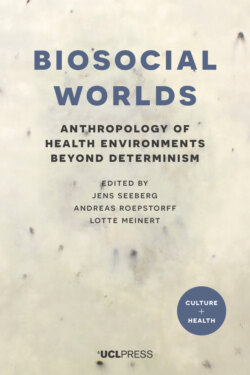Biosocial Worlds

Реклама. ООО «ЛитРес», ИНН: 7719571260.
Оглавление
Группа авторов. Biosocial Worlds
Contents
List of figures
Notes on contributors
Introduction
Projection
Health environment
Scale
Synergies
Beyond determinism
References
Chapter 1 Permeable Bodies and Environmental Delineation
Traumatised environments
Behavioural epigenetics
The reactive genome
Sculpting the genome
The epigenetic explosion
The embodiment of trauma
Epigenetics and miniaturised environments
Agent Orange: Lasting effects in time and space
Food as environment
Eliminating stunting
Toxic living
The intergenerational transmission of toxins
Social isolation
Colonisation and historical trauma
Conclusions
References
Chapter 2 Situating Biologies: Studying Human Differentiation as Material-Semiotic Practice
Introduction: Differences in anthropology and biology
Molecular biology of social position
Life scientific perspectives: Treating culture as nature
Social scientific perspectives: Narrating the body
Situating biologies: Differentiation as material-semiotic practice
In conclusion: Appreciating biological regularities
References
Chapter 3 Pig–Human Relations in Neonatology: Knowing and Unknowing in a Multi-Species Collaborative
Translating pigs into human health
Imagining and claiming pigs as resources for health
Making resources in the laboratory
Bringing the pig-based resources out of the laboratory
Managing resources in the NICU
Knowing and unknowing in translational medicine
Coda
References
Chapter 4 Anthropology’s End to Biodeterminism: A New Sociobiology
Sociobiology reconsidered
Darwin and stable change
Selfish genes?
Bio-prejudice and biodeterminism: The diabetes example
A new ontology
References
Chapter 5 Tribes without Rulers: Bacteria Life in the Human Holobiont1
Part One: The cell state
Part Two: Bacterial society
Part Three: Biofilms
Part Four: The human microbiome
Part Five: Bacteria’s brain
Part Six: The social life of enteric bacteria
Conclusion: A question and less-than-satisfactory answer
References
Chapter 6 Biosocial Dynamics of Multidrug-Resistant Tuberculosis: A Bacterial Perspective
Increasing access to medicines
Phages
TB control in India
Contamination and configuration: TB treatment as an epidemic
Configuring the spread of TB treatment
Multidrug-resistant tuberculosis in India
Resistance-driven technologies
Between nature and culture
References
Chapter 7 When Sickness Comes in Multiples: Co-morbidity in Botswana
Introduction: Situations of complexity
Botswana’s epidemiology of co-infection
Tuberculosis: The colonial epidemic
HIV/AIDS: The epidemic of national existential emergency
Cancer: The emerging epidemic
Receiving a differential diagnosis
Clinical intelligibility
Living and dying with co-infection
Provisional conclusions
References
Chapter 8 Legacies of Violence: The Communicability of Spirits and Trauma in Northern Uganda
Studying legacies of violence
Cen: The ghosts of the resentful dead
Trauma and its treatment
The co-existence of cen and trauma4
Co-morbidity and syndemics
A syndemic of problems
References
Chapter 9 Extinction and Time amid Climate Change or What is a Horizon?
Crossing points of no return
On the nature of ‘catastrophic’ forms
Navigating non-parametric worlds
Horizoning work
Biodeterminisms versus ‘remote futures’
References
Afterword: Getting Closer?
Do the new sciences of plasticity lead natural science practitioners toward the insights of anthropology?
Might anthropological fieldwork on scientific turf raise problems already inside science and thus subject to prior engagement across the disciplines?
What anthropological findings push the new sciences into open dialogue?
How is anthropology changing – and changing its scientific interlocutors?
What’s ahead for ‘bioindeterminism?’
References
Index
Отрывок из книги
CULTURE AND HEALTH
Series Editors
.....
1. https://www.benefits.va.gov/compensation/claims-special-birth_defects.asp.
2. Marasmus and kwashiorkor are two common forms of serious protein-energy malnutrition.
.....